NSB303 Partnerships in Health: Colorectal Cancer Discharge Plan
VerifiedAdded on 2023/06/12
|12
|3091
|265
Case Study
AI Summary
This case study solution provides a comprehensive discharge and self-management plan for a patient, John, completing adjuvant chemotherapy for colorectal cancer. The plan addresses crucial aspects of post-treatment care, including hotlines for survivors, timely drug administration, screening recommendations, lifestyle modifications (avoiding smoking, engaging in regular exercise, and maintaining a healthy diet), and the application of transition care and transition theory models. It highlights the importance of recognizing potential symptoms, such as changes in bowel habits, rectal bleeding, abdominal pain, fatigue, and weight loss, and recommends various diagnostic tests, including blood tests (CBC, tumor markers, liver enzyme), diagnostic colonoscopy, biopsy, and PET scans. The solution also emphasizes education and self-management strategies to address physical, psychological, social, and spiritual issues faced by colorectal cancer survivors, including screening for post-traumatic stress and depression, addressing workplace concerns, promoting healthy lifestyles, managing physical side effects, and incorporating spiritual aspects into care. The application of Orem’s theory is discussed as a framework for maintaining wellbeing and health through self-care activities, and essential guidelines for cancer survivors are provided, such as engaging in regular physical activity, maintaining a healthy weight, consuming vegetables and fruits, and avoiding liquor, smoking, and processed meats. The assignment solution is available on Desklib, a platform offering study tools and resources for students.

Running head: CANCER DIAGNOSIS 1
Cancer Diagnosis
Student Name
Institution Affiliation
Cancer Diagnosis
Student Name
Institution Affiliation
Paraphrase This Document
Need a fresh take? Get an instant paraphrase of this document with our AI Paraphraser
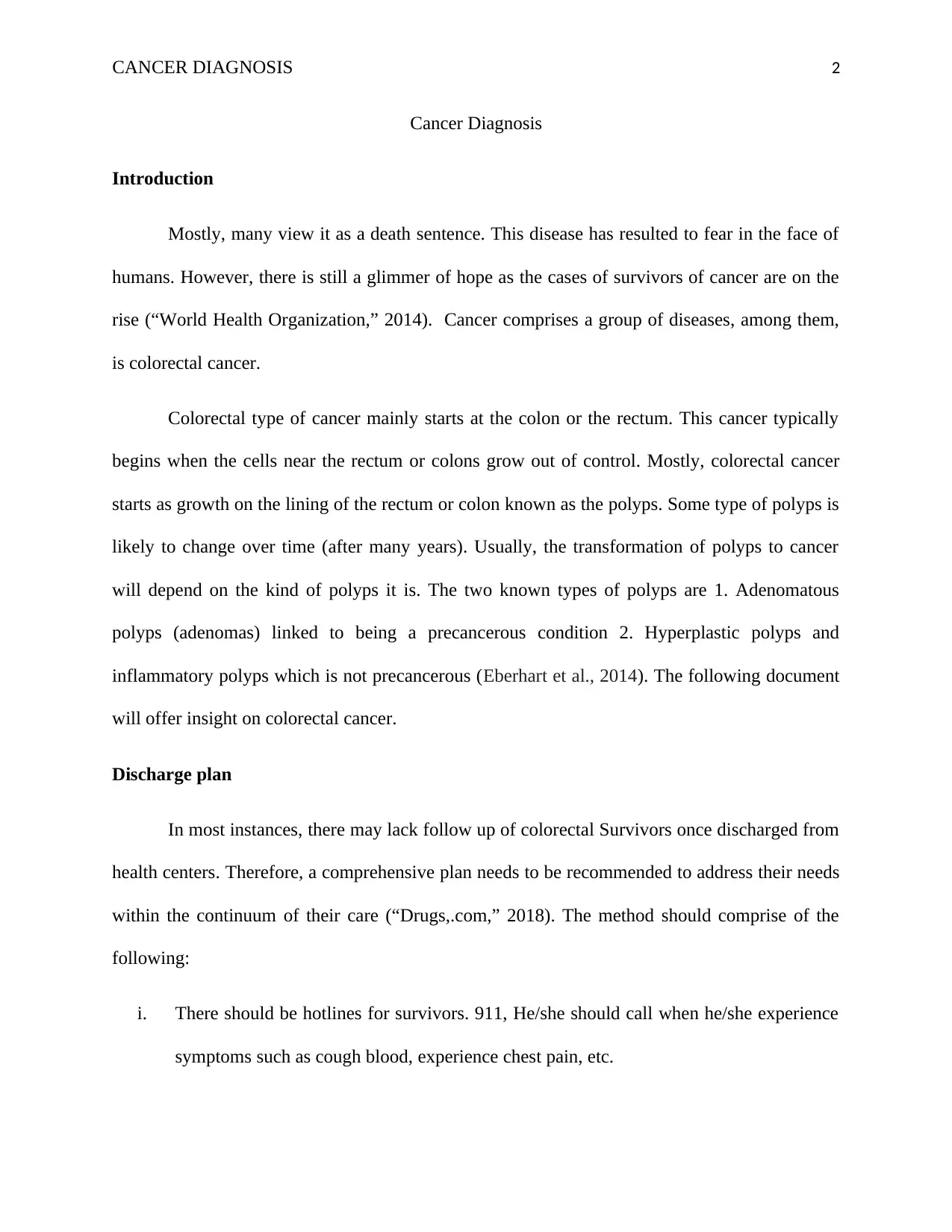
CANCER DIAGNOSIS 2
Cancer Diagnosis
Introduction
Mostly, many view it as a death sentence. This disease has resulted to fear in the face of
humans. However, there is still a glimmer of hope as the cases of survivors of cancer are on the
rise (“World Health Organization,” 2014). Cancer comprises a group of diseases, among them,
is colorectal cancer.
Colorectal type of cancer mainly starts at the colon or the rectum. This cancer typically
begins when the cells near the rectum or colons grow out of control. Mostly, colorectal cancer
starts as growth on the lining of the rectum or colon known as the polyps. Some type of polyps is
likely to change over time (after many years). Usually, the transformation of polyps to cancer
will depend on the kind of polyps it is. The two known types of polyps are 1. Adenomatous
polyps (adenomas) linked to being a precancerous condition 2. Hyperplastic polyps and
inflammatory polyps which is not precancerous (Eberhart et al., 2014). The following document
will offer insight on colorectal cancer.
Discharge plan
In most instances, there may lack follow up of colorectal Survivors once discharged from
health centers. Therefore, a comprehensive plan needs to be recommended to address their needs
within the continuum of their care (“Drugs,.com,” 2018). The method should comprise of the
following:
i. There should be hotlines for survivors. 911, He/she should call when he/she experience
symptoms such as cough blood, experience chest pain, etc.
Cancer Diagnosis
Introduction
Mostly, many view it as a death sentence. This disease has resulted to fear in the face of
humans. However, there is still a glimmer of hope as the cases of survivors of cancer are on the
rise (“World Health Organization,” 2014). Cancer comprises a group of diseases, among them,
is colorectal cancer.
Colorectal type of cancer mainly starts at the colon or the rectum. This cancer typically
begins when the cells near the rectum or colons grow out of control. Mostly, colorectal cancer
starts as growth on the lining of the rectum or colon known as the polyps. Some type of polyps is
likely to change over time (after many years). Usually, the transformation of polyps to cancer
will depend on the kind of polyps it is. The two known types of polyps are 1. Adenomatous
polyps (adenomas) linked to being a precancerous condition 2. Hyperplastic polyps and
inflammatory polyps which is not precancerous (Eberhart et al., 2014). The following document
will offer insight on colorectal cancer.
Discharge plan
In most instances, there may lack follow up of colorectal Survivors once discharged from
health centers. Therefore, a comprehensive plan needs to be recommended to address their needs
within the continuum of their care (“Drugs,.com,” 2018). The method should comprise of the
following:
i. There should be hotlines for survivors. 911, He/she should call when he/she experience
symptoms such as cough blood, experience chest pain, etc.
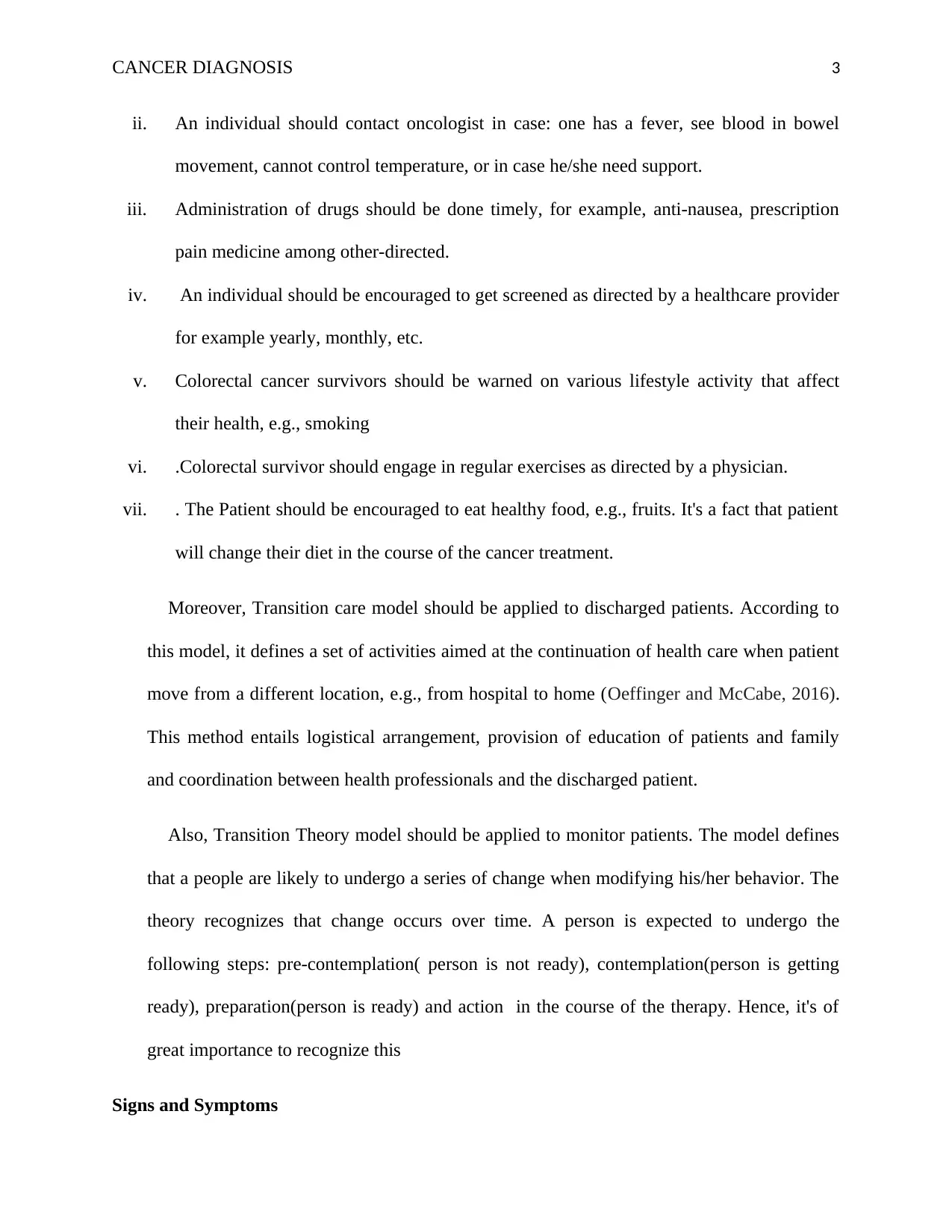
CANCER DIAGNOSIS 3
ii. An individual should contact oncologist in case: one has a fever, see blood in bowel
movement, cannot control temperature, or in case he/she need support.
iii. Administration of drugs should be done timely, for example, anti-nausea, prescription
pain medicine among other-directed.
iv. An individual should be encouraged to get screened as directed by a healthcare provider
for example yearly, monthly, etc.
v. Colorectal cancer survivors should be warned on various lifestyle activity that affect
their health, e.g., smoking
vi. .Colorectal survivor should engage in regular exercises as directed by a physician.
vii. . The Patient should be encouraged to eat healthy food, e.g., fruits. It's a fact that patient
will change their diet in the course of the cancer treatment.
Moreover, Transition care model should be applied to discharged patients. According to
this model, it defines a set of activities aimed at the continuation of health care when patient
move from a different location, e.g., from hospital to home (Oeffinger and McCabe, 2016).
This method entails logistical arrangement, provision of education of patients and family
and coordination between health professionals and the discharged patient.
Also, Transition Theory model should be applied to monitor patients. The model defines
that a people are likely to undergo a series of change when modifying his/her behavior. The
theory recognizes that change occurs over time. A person is expected to undergo the
following steps: pre-contemplation( person is not ready), contemplation(person is getting
ready), preparation(person is ready) and action in the course of the therapy. Hence, it's of
great importance to recognize this
Signs and Symptoms
ii. An individual should contact oncologist in case: one has a fever, see blood in bowel
movement, cannot control temperature, or in case he/she need support.
iii. Administration of drugs should be done timely, for example, anti-nausea, prescription
pain medicine among other-directed.
iv. An individual should be encouraged to get screened as directed by a healthcare provider
for example yearly, monthly, etc.
v. Colorectal cancer survivors should be warned on various lifestyle activity that affect
their health, e.g., smoking
vi. .Colorectal survivor should engage in regular exercises as directed by a physician.
vii. . The Patient should be encouraged to eat healthy food, e.g., fruits. It's a fact that patient
will change their diet in the course of the cancer treatment.
Moreover, Transition care model should be applied to discharged patients. According to
this model, it defines a set of activities aimed at the continuation of health care when patient
move from a different location, e.g., from hospital to home (Oeffinger and McCabe, 2016).
This method entails logistical arrangement, provision of education of patients and family
and coordination between health professionals and the discharged patient.
Also, Transition Theory model should be applied to monitor patients. The model defines
that a people are likely to undergo a series of change when modifying his/her behavior. The
theory recognizes that change occurs over time. A person is expected to undergo the
following steps: pre-contemplation( person is not ready), contemplation(person is getting
ready), preparation(person is ready) and action in the course of the therapy. Hence, it's of
great importance to recognize this
Signs and Symptoms
⊘ This is a preview!⊘
Do you want full access?
Subscribe today to unlock all pages.

Trusted by 1+ million students worldwide
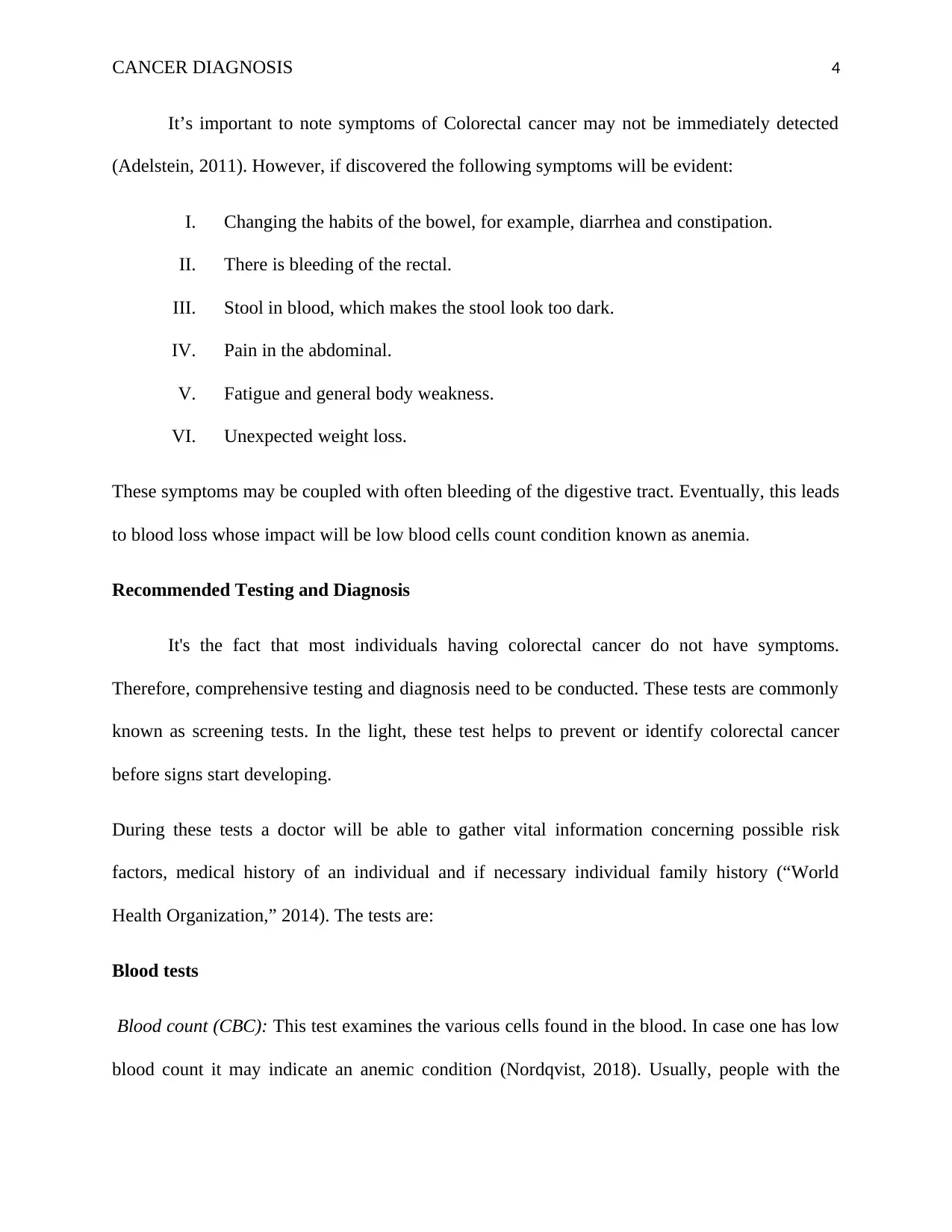
CANCER DIAGNOSIS 4
It’s important to note symptoms of Colorectal cancer may not be immediately detected
(Adelstein, 2011). However, if discovered the following symptoms will be evident:
I. Changing the habits of the bowel, for example, diarrhea and constipation.
II. There is bleeding of the rectal.
III. Stool in blood, which makes the stool look too dark.
IV. Pain in the abdominal.
V. Fatigue and general body weakness.
VI. Unexpected weight loss.
These symptoms may be coupled with often bleeding of the digestive tract. Eventually, this leads
to blood loss whose impact will be low blood cells count condition known as anemia.
Recommended Testing and Diagnosis
It's the fact that most individuals having colorectal cancer do not have symptoms.
Therefore, comprehensive testing and diagnosis need to be conducted. These tests are commonly
known as screening tests. In the light, these test helps to prevent or identify colorectal cancer
before signs start developing.
During these tests a doctor will be able to gather vital information concerning possible risk
factors, medical history of an individual and if necessary individual family history (“World
Health Organization,” 2014). The tests are:
Blood tests
Blood count (CBC): This test examines the various cells found in the blood. In case one has low
blood count it may indicate an anemic condition (Nordqvist, 2018). Usually, people with the
It’s important to note symptoms of Colorectal cancer may not be immediately detected
(Adelstein, 2011). However, if discovered the following symptoms will be evident:
I. Changing the habits of the bowel, for example, diarrhea and constipation.
II. There is bleeding of the rectal.
III. Stool in blood, which makes the stool look too dark.
IV. Pain in the abdominal.
V. Fatigue and general body weakness.
VI. Unexpected weight loss.
These symptoms may be coupled with often bleeding of the digestive tract. Eventually, this leads
to blood loss whose impact will be low blood cells count condition known as anemia.
Recommended Testing and Diagnosis
It's the fact that most individuals having colorectal cancer do not have symptoms.
Therefore, comprehensive testing and diagnosis need to be conducted. These tests are commonly
known as screening tests. In the light, these test helps to prevent or identify colorectal cancer
before signs start developing.
During these tests a doctor will be able to gather vital information concerning possible risk
factors, medical history of an individual and if necessary individual family history (“World
Health Organization,” 2014). The tests are:
Blood tests
Blood count (CBC): This test examines the various cells found in the blood. In case one has low
blood count it may indicate an anemic condition (Nordqvist, 2018). Usually, people with the
Paraphrase This Document
Need a fresh take? Get an instant paraphrase of this document with our AI Paraphraser
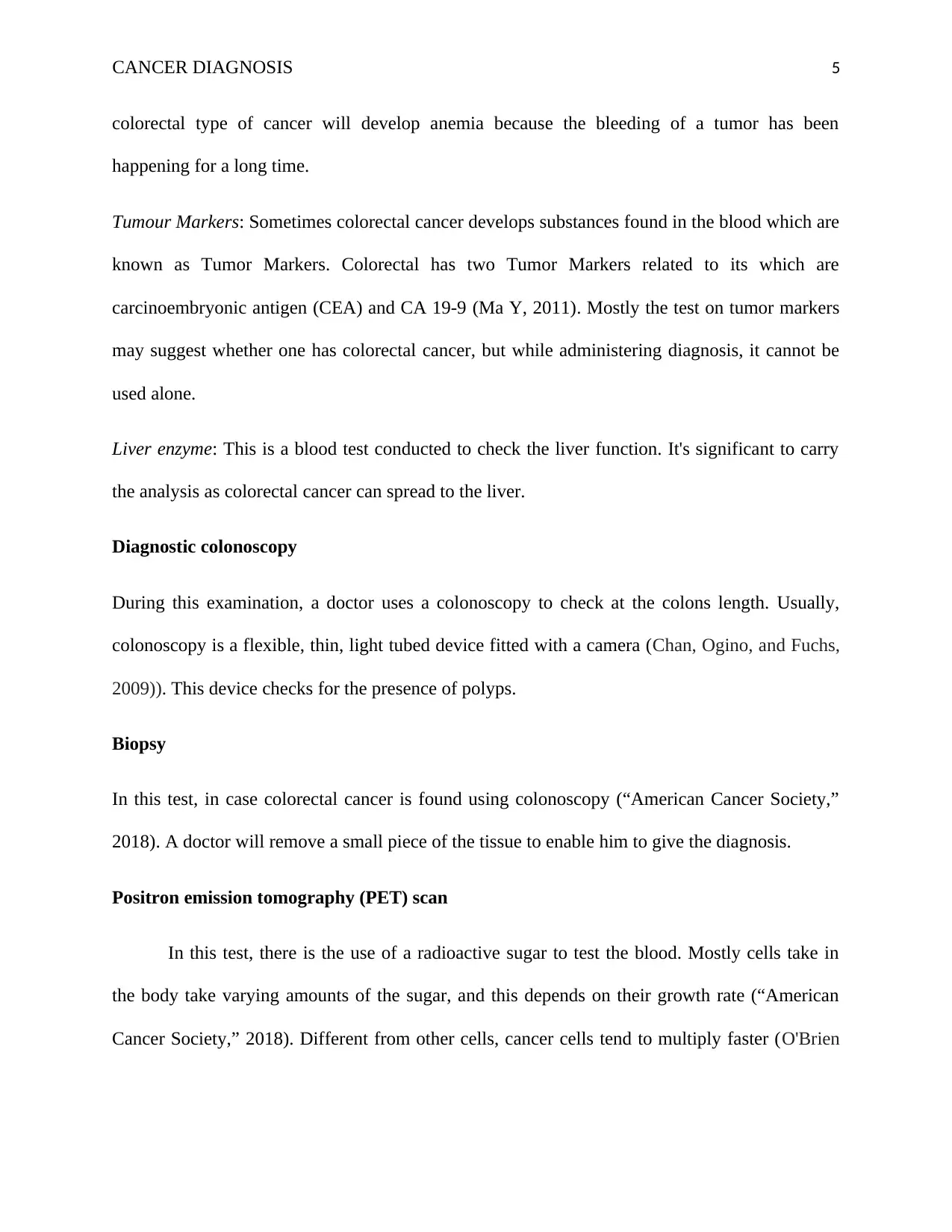
CANCER DIAGNOSIS 5
colorectal type of cancer will develop anemia because the bleeding of a tumor has been
happening for a long time.
Tumour Markers: Sometimes colorectal cancer develops substances found in the blood which are
known as Tumor Markers. Colorectal has two Tumor Markers related to its which are
carcinoembryonic antigen (CEA) and CA 19-9 (Ma Y, 2011). Mostly the test on tumor markers
may suggest whether one has colorectal cancer, but while administering diagnosis, it cannot be
used alone.
Liver enzyme: This is a blood test conducted to check the liver function. It's significant to carry
the analysis as colorectal cancer can spread to the liver.
Diagnostic colonoscopy
During this examination, a doctor uses a colonoscopy to check at the colons length. Usually,
colonoscopy is a flexible, thin, light tubed device fitted with a camera (Chan, Ogino, and Fuchs,
2009)). This device checks for the presence of polyps.
Biopsy
In this test, in case colorectal cancer is found using colonoscopy (“American Cancer Society,”
2018). A doctor will remove a small piece of the tissue to enable him to give the diagnosis.
Positron emission tomography (PET) scan
In this test, there is the use of a radioactive sugar to test the blood. Mostly cells take in
the body take varying amounts of the sugar, and this depends on their growth rate (“American
Cancer Society,” 2018). Different from other cells, cancer cells tend to multiply faster (O'Brien
colorectal type of cancer will develop anemia because the bleeding of a tumor has been
happening for a long time.
Tumour Markers: Sometimes colorectal cancer develops substances found in the blood which are
known as Tumor Markers. Colorectal has two Tumor Markers related to its which are
carcinoembryonic antigen (CEA) and CA 19-9 (Ma Y, 2011). Mostly the test on tumor markers
may suggest whether one has colorectal cancer, but while administering diagnosis, it cannot be
used alone.
Liver enzyme: This is a blood test conducted to check the liver function. It's significant to carry
the analysis as colorectal cancer can spread to the liver.
Diagnostic colonoscopy
During this examination, a doctor uses a colonoscopy to check at the colons length. Usually,
colonoscopy is a flexible, thin, light tubed device fitted with a camera (Chan, Ogino, and Fuchs,
2009)). This device checks for the presence of polyps.
Biopsy
In this test, in case colorectal cancer is found using colonoscopy (“American Cancer Society,”
2018). A doctor will remove a small piece of the tissue to enable him to give the diagnosis.
Positron emission tomography (PET) scan
In this test, there is the use of a radioactive sugar to test the blood. Mostly cells take in
the body take varying amounts of the sugar, and this depends on their growth rate (“American
Cancer Society,” 2018). Different from other cells, cancer cells tend to multiply faster (O'Brien
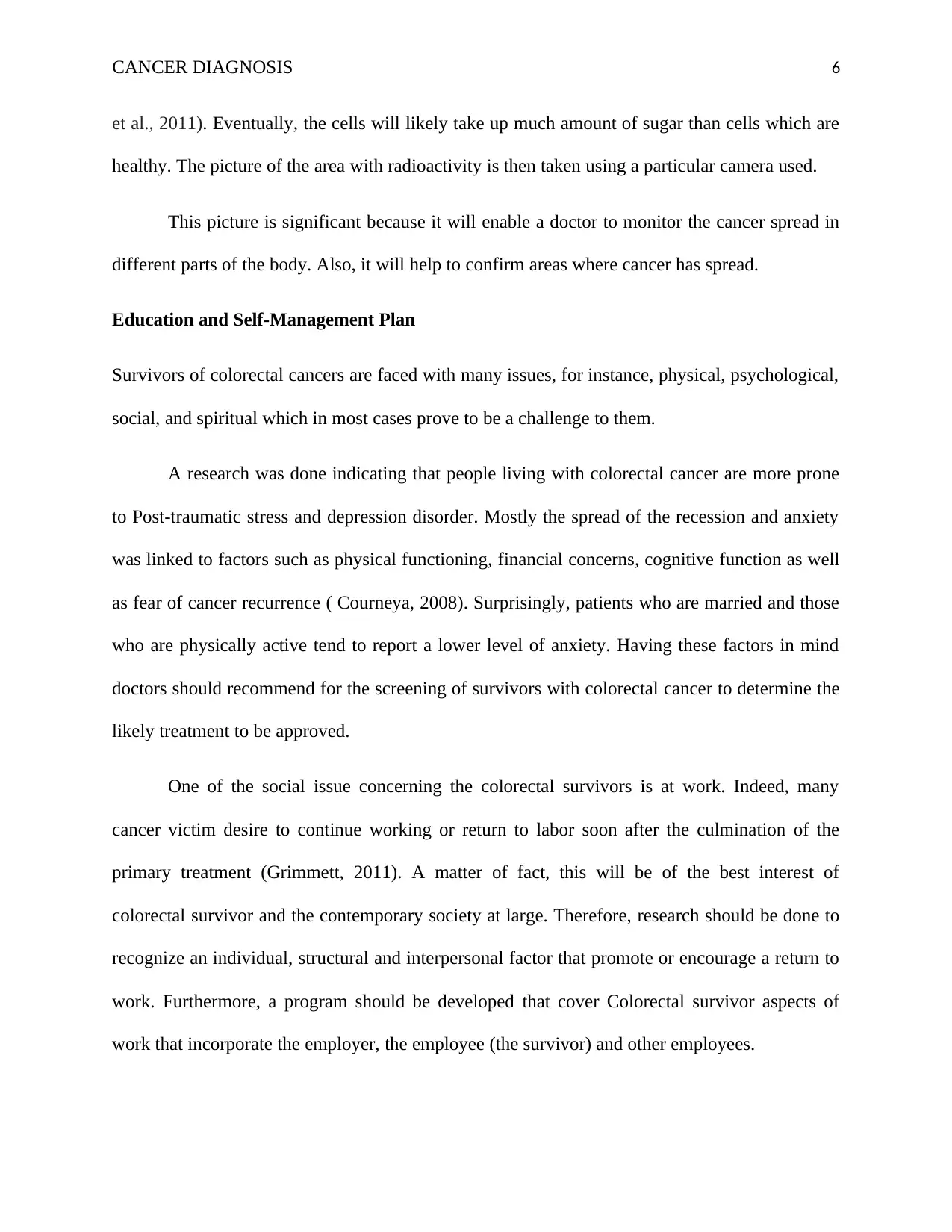
CANCER DIAGNOSIS 6
et al., 2011). Eventually, the cells will likely take up much amount of sugar than cells which are
healthy. The picture of the area with radioactivity is then taken using a particular camera used.
This picture is significant because it will enable a doctor to monitor the cancer spread in
different parts of the body. Also, it will help to confirm areas where cancer has spread.
Education and Self-Management Plan
Survivors of colorectal cancers are faced with many issues, for instance, physical, psychological,
social, and spiritual which in most cases prove to be a challenge to them.
A research was done indicating that people living with colorectal cancer are more prone
to Post-traumatic stress and depression disorder. Mostly the spread of the recession and anxiety
was linked to factors such as physical functioning, financial concerns, cognitive function as well
as fear of cancer recurrence ( Courneya, 2008). Surprisingly, patients who are married and those
who are physically active tend to report a lower level of anxiety. Having these factors in mind
doctors should recommend for the screening of survivors with colorectal cancer to determine the
likely treatment to be approved.
One of the social issue concerning the colorectal survivors is at work. Indeed, many
cancer victim desire to continue working or return to labor soon after the culmination of the
primary treatment (Grimmett, 2011). A matter of fact, this will be of the best interest of
colorectal survivor and the contemporary society at large. Therefore, research should be done to
recognize an individual, structural and interpersonal factor that promote or encourage a return to
work. Furthermore, a program should be developed that cover Colorectal survivor aspects of
work that incorporate the employer, the employee (the survivor) and other employees.
et al., 2011). Eventually, the cells will likely take up much amount of sugar than cells which are
healthy. The picture of the area with radioactivity is then taken using a particular camera used.
This picture is significant because it will enable a doctor to monitor the cancer spread in
different parts of the body. Also, it will help to confirm areas where cancer has spread.
Education and Self-Management Plan
Survivors of colorectal cancers are faced with many issues, for instance, physical, psychological,
social, and spiritual which in most cases prove to be a challenge to them.
A research was done indicating that people living with colorectal cancer are more prone
to Post-traumatic stress and depression disorder. Mostly the spread of the recession and anxiety
was linked to factors such as physical functioning, financial concerns, cognitive function as well
as fear of cancer recurrence ( Courneya, 2008). Surprisingly, patients who are married and those
who are physically active tend to report a lower level of anxiety. Having these factors in mind
doctors should recommend for the screening of survivors with colorectal cancer to determine the
likely treatment to be approved.
One of the social issue concerning the colorectal survivors is at work. Indeed, many
cancer victim desire to continue working or return to labor soon after the culmination of the
primary treatment (Grimmett, 2011). A matter of fact, this will be of the best interest of
colorectal survivor and the contemporary society at large. Therefore, research should be done to
recognize an individual, structural and interpersonal factor that promote or encourage a return to
work. Furthermore, a program should be developed that cover Colorectal survivor aspects of
work that incorporate the employer, the employee (the survivor) and other employees.
⊘ This is a preview!⊘
Do you want full access?
Subscribe today to unlock all pages.

Trusted by 1+ million students worldwide
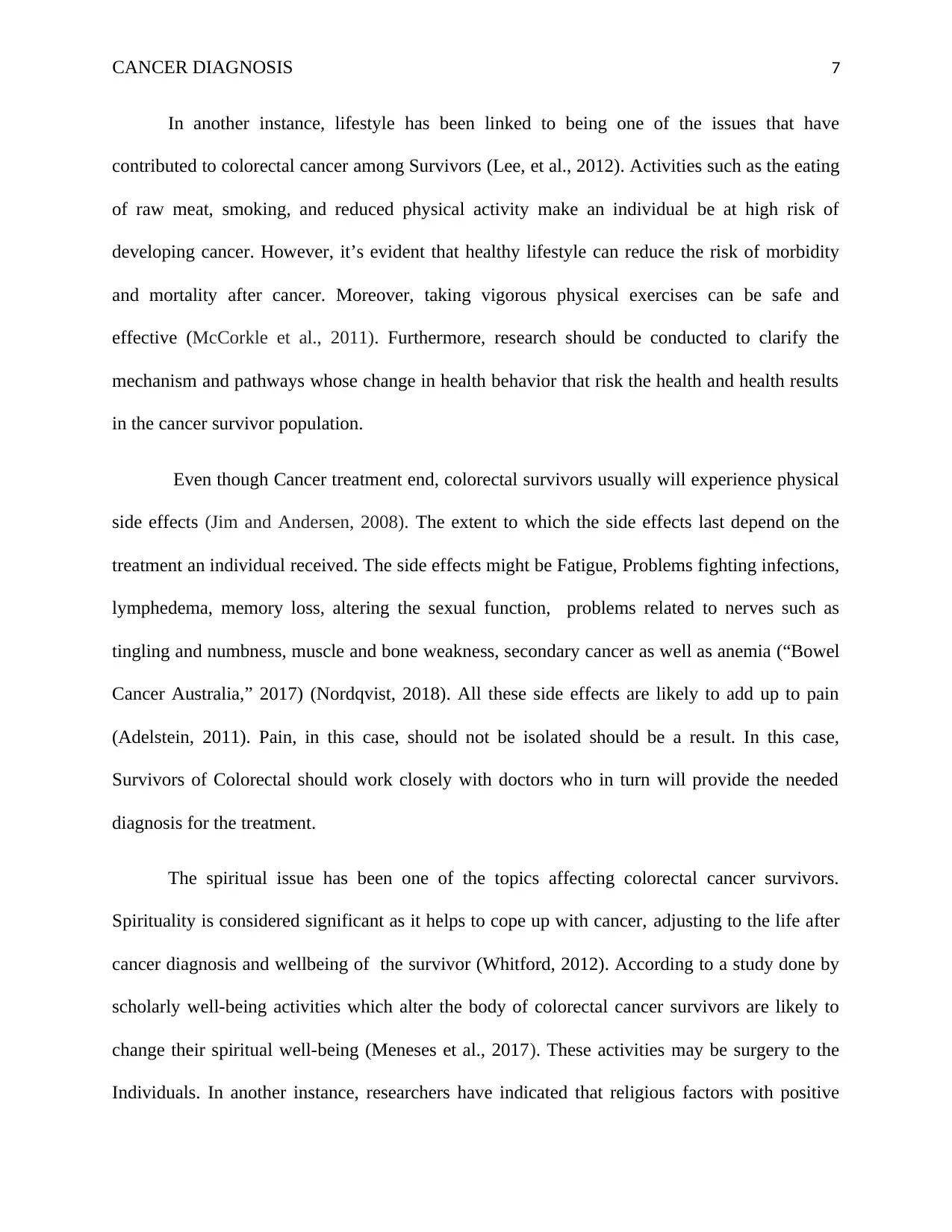
CANCER DIAGNOSIS 7
In another instance, lifestyle has been linked to being one of the issues that have
contributed to colorectal cancer among Survivors (Lee, et al., 2012). Activities such as the eating
of raw meat, smoking, and reduced physical activity make an individual be at high risk of
developing cancer. However, it’s evident that healthy lifestyle can reduce the risk of morbidity
and mortality after cancer. Moreover, taking vigorous physical exercises can be safe and
effective (McCorkle et al., 2011). Furthermore, research should be conducted to clarify the
mechanism and pathways whose change in health behavior that risk the health and health results
in the cancer survivor population.
Even though Cancer treatment end, colorectal survivors usually will experience physical
side effects (Jim and Andersen, 2008). The extent to which the side effects last depend on the
treatment an individual received. The side effects might be Fatigue, Problems fighting infections,
lymphedema, memory loss, altering the sexual function, problems related to nerves such as
tingling and numbness, muscle and bone weakness, secondary cancer as well as anemia (“Bowel
Cancer Australia,” 2017) (Nordqvist, 2018). All these side effects are likely to add up to pain
(Adelstein, 2011). Pain, in this case, should not be isolated should be a result. In this case,
Survivors of Colorectal should work closely with doctors who in turn will provide the needed
diagnosis for the treatment.
The spiritual issue has been one of the topics affecting colorectal cancer survivors.
Spirituality is considered significant as it helps to cope up with cancer, adjusting to the life after
cancer diagnosis and wellbeing of the survivor (Whitford, 2012). According to a study done by
scholarly well-being activities which alter the body of colorectal cancer survivors are likely to
change their spiritual well-being (Meneses et al., 2017). These activities may be surgery to the
Individuals. In another instance, researchers have indicated that religious factors with positive
In another instance, lifestyle has been linked to being one of the issues that have
contributed to colorectal cancer among Survivors (Lee, et al., 2012). Activities such as the eating
of raw meat, smoking, and reduced physical activity make an individual be at high risk of
developing cancer. However, it’s evident that healthy lifestyle can reduce the risk of morbidity
and mortality after cancer. Moreover, taking vigorous physical exercises can be safe and
effective (McCorkle et al., 2011). Furthermore, research should be conducted to clarify the
mechanism and pathways whose change in health behavior that risk the health and health results
in the cancer survivor population.
Even though Cancer treatment end, colorectal survivors usually will experience physical
side effects (Jim and Andersen, 2008). The extent to which the side effects last depend on the
treatment an individual received. The side effects might be Fatigue, Problems fighting infections,
lymphedema, memory loss, altering the sexual function, problems related to nerves such as
tingling and numbness, muscle and bone weakness, secondary cancer as well as anemia (“Bowel
Cancer Australia,” 2017) (Nordqvist, 2018). All these side effects are likely to add up to pain
(Adelstein, 2011). Pain, in this case, should not be isolated should be a result. In this case,
Survivors of Colorectal should work closely with doctors who in turn will provide the needed
diagnosis for the treatment.
The spiritual issue has been one of the topics affecting colorectal cancer survivors.
Spirituality is considered significant as it helps to cope up with cancer, adjusting to the life after
cancer diagnosis and wellbeing of the survivor (Whitford, 2012). According to a study done by
scholarly well-being activities which alter the body of colorectal cancer survivors are likely to
change their spiritual well-being (Meneses et al., 2017). These activities may be surgery to the
Individuals. In another instance, researchers have indicated that religious factors with positive
Paraphrase This Document
Need a fresh take? Get an instant paraphrase of this document with our AI Paraphraser
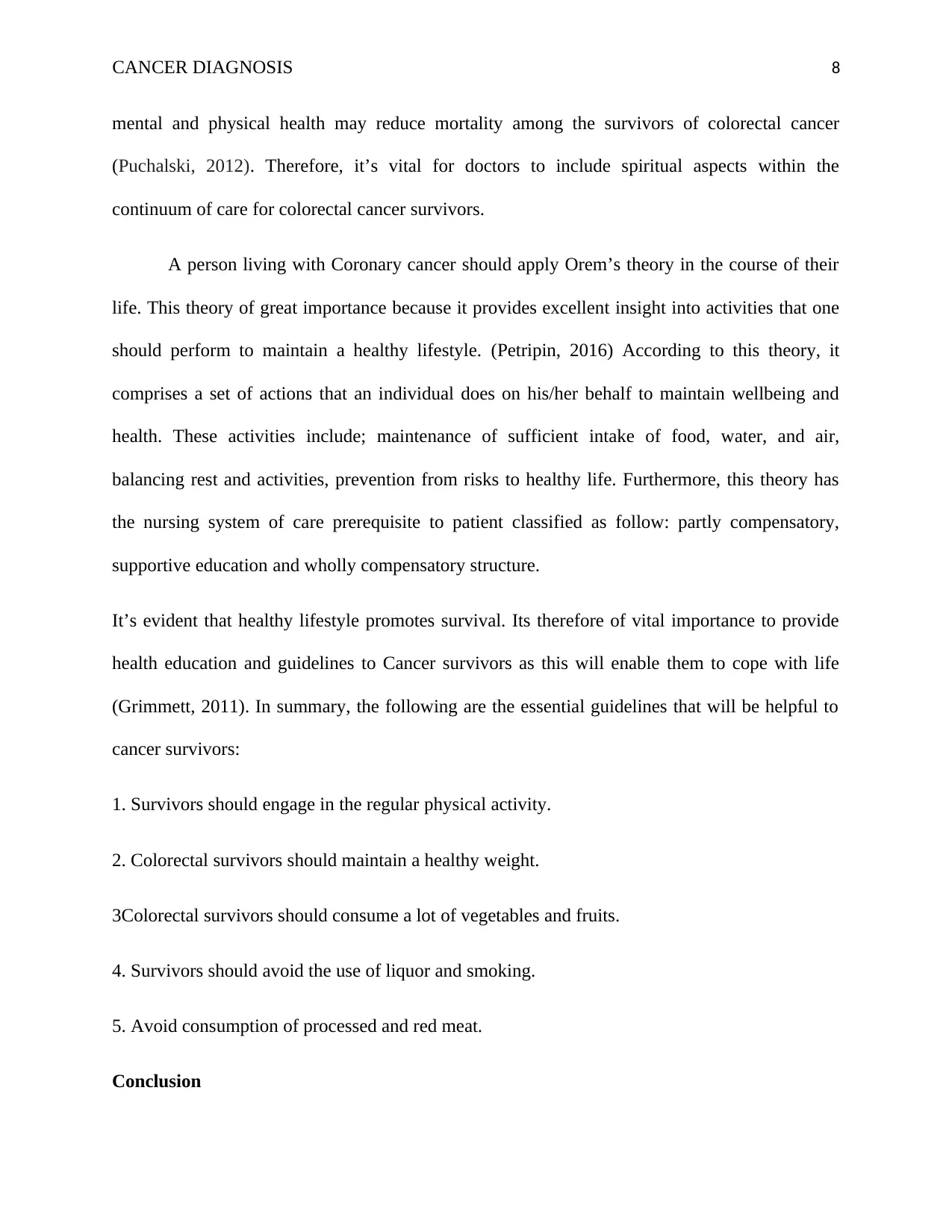
CANCER DIAGNOSIS 8
mental and physical health may reduce mortality among the survivors of colorectal cancer
(Puchalski, 2012). Therefore, it’s vital for doctors to include spiritual aspects within the
continuum of care for colorectal cancer survivors.
A person living with Coronary cancer should apply Orem’s theory in the course of their
life. This theory of great importance because it provides excellent insight into activities that one
should perform to maintain a healthy lifestyle. (Petripin, 2016) According to this theory, it
comprises a set of actions that an individual does on his/her behalf to maintain wellbeing and
health. These activities include; maintenance of sufficient intake of food, water, and air,
balancing rest and activities, prevention from risks to healthy life. Furthermore, this theory has
the nursing system of care prerequisite to patient classified as follow: partly compensatory,
supportive education and wholly compensatory structure.
It’s evident that healthy lifestyle promotes survival. Its therefore of vital importance to provide
health education and guidelines to Cancer survivors as this will enable them to cope with life
(Grimmett, 2011). In summary, the following are the essential guidelines that will be helpful to
cancer survivors:
1. Survivors should engage in the regular physical activity.
2. Colorectal survivors should maintain a healthy weight.
3Colorectal survivors should consume a lot of vegetables and fruits.
4. Survivors should avoid the use of liquor and smoking.
5. Avoid consumption of processed and red meat.
Conclusion
mental and physical health may reduce mortality among the survivors of colorectal cancer
(Puchalski, 2012). Therefore, it’s vital for doctors to include spiritual aspects within the
continuum of care for colorectal cancer survivors.
A person living with Coronary cancer should apply Orem’s theory in the course of their
life. This theory of great importance because it provides excellent insight into activities that one
should perform to maintain a healthy lifestyle. (Petripin, 2016) According to this theory, it
comprises a set of actions that an individual does on his/her behalf to maintain wellbeing and
health. These activities include; maintenance of sufficient intake of food, water, and air,
balancing rest and activities, prevention from risks to healthy life. Furthermore, this theory has
the nursing system of care prerequisite to patient classified as follow: partly compensatory,
supportive education and wholly compensatory structure.
It’s evident that healthy lifestyle promotes survival. Its therefore of vital importance to provide
health education and guidelines to Cancer survivors as this will enable them to cope with life
(Grimmett, 2011). In summary, the following are the essential guidelines that will be helpful to
cancer survivors:
1. Survivors should engage in the regular physical activity.
2. Colorectal survivors should maintain a healthy weight.
3Colorectal survivors should consume a lot of vegetables and fruits.
4. Survivors should avoid the use of liquor and smoking.
5. Avoid consumption of processed and red meat.
Conclusion
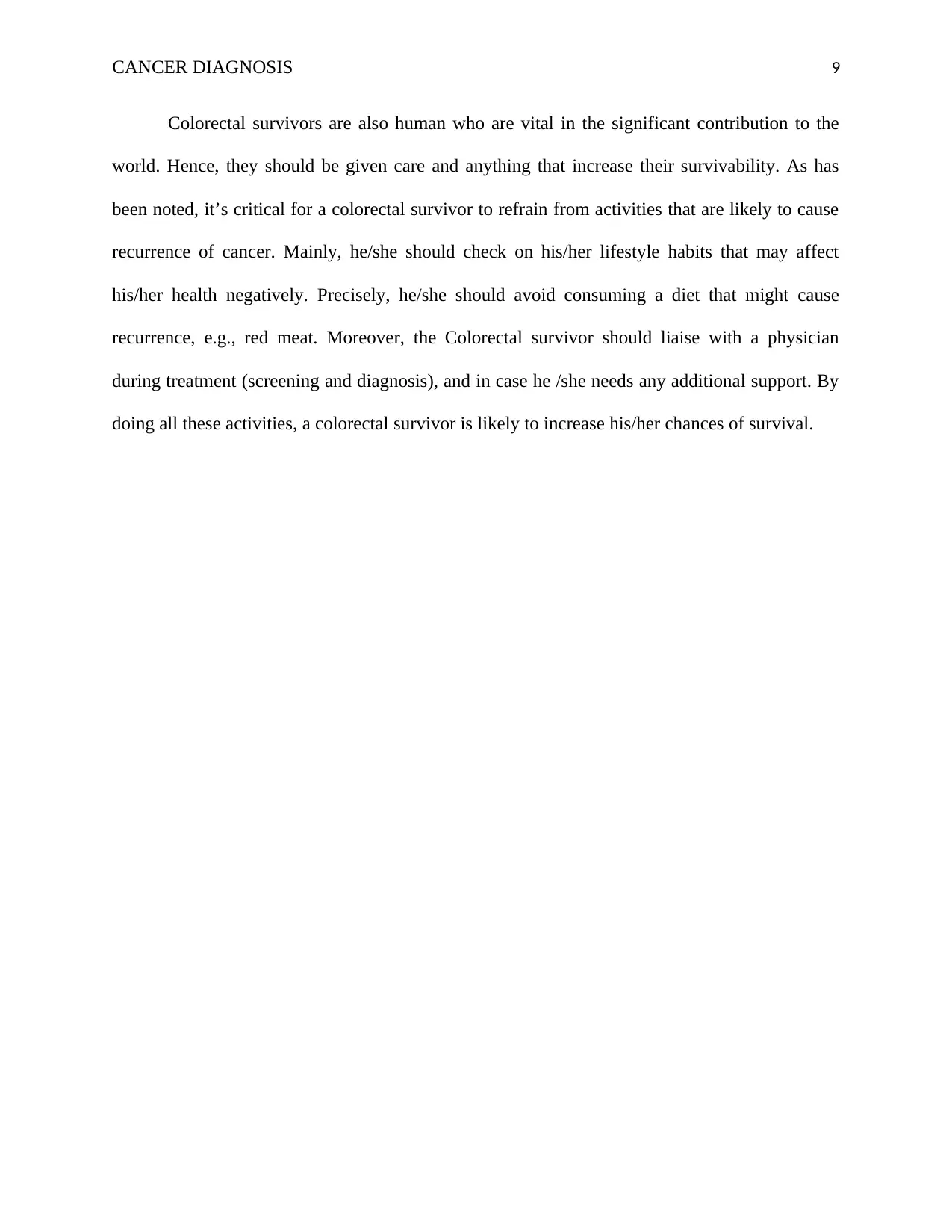
CANCER DIAGNOSIS 9
Colorectal survivors are also human who are vital in the significant contribution to the
world. Hence, they should be given care and anything that increase their survivability. As has
been noted, it’s critical for a colorectal survivor to refrain from activities that are likely to cause
recurrence of cancer. Mainly, he/she should check on his/her lifestyle habits that may affect
his/her health negatively. Precisely, he/she should avoid consuming a diet that might cause
recurrence, e.g., red meat. Moreover, the Colorectal survivor should liaise with a physician
during treatment (screening and diagnosis), and in case he /she needs any additional support. By
doing all these activities, a colorectal survivor is likely to increase his/her chances of survival.
Colorectal survivors are also human who are vital in the significant contribution to the
world. Hence, they should be given care and anything that increase their survivability. As has
been noted, it’s critical for a colorectal survivor to refrain from activities that are likely to cause
recurrence of cancer. Mainly, he/she should check on his/her lifestyle habits that may affect
his/her health negatively. Precisely, he/she should avoid consuming a diet that might cause
recurrence, e.g., red meat. Moreover, the Colorectal survivor should liaise with a physician
during treatment (screening and diagnosis), and in case he /she needs any additional support. By
doing all these activities, a colorectal survivor is likely to increase his/her chances of survival.
⊘ This is a preview!⊘
Do you want full access?
Subscribe today to unlock all pages.

Trusted by 1+ million students worldwide
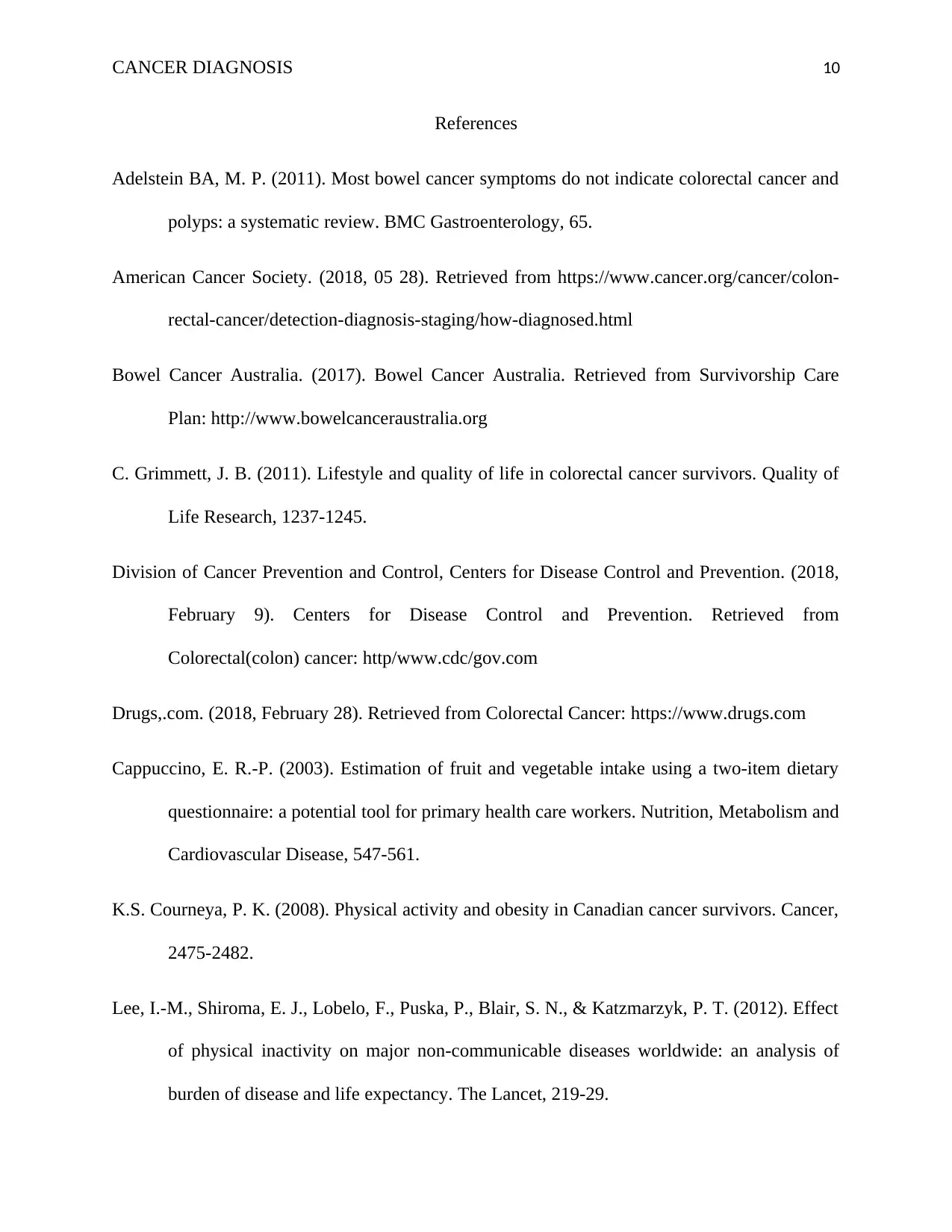
CANCER DIAGNOSIS 10
References
Adelstein BA, M. P. (2011). Most bowel cancer symptoms do not indicate colorectal cancer and
polyps: a systematic review. BMC Gastroenterology, 65.
American Cancer Society. (2018, 05 28). Retrieved from https://www.cancer.org/cancer/colon-
rectal-cancer/detection-diagnosis-staging/how-diagnosed.html
Bowel Cancer Australia. (2017). Bowel Cancer Australia. Retrieved from Survivorship Care
Plan: http://www.bowelcanceraustralia.org
C. Grimmett, J. B. (2011). Lifestyle and quality of life in colorectal cancer survivors. Quality of
Life Research, 1237-1245.
Division of Cancer Prevention and Control, Centers for Disease Control and Prevention. (2018,
February 9). Centers for Disease Control and Prevention. Retrieved from
Colorectal(colon) cancer: http/www.cdc/gov.com
Drugs,.com. (2018, February 28). Retrieved from Colorectal Cancer: https://www.drugs.com
Cappuccino, E. R.-P. (2003). Estimation of fruit and vegetable intake using a two-item dietary
questionnaire: a potential tool for primary health care workers. Nutrition, Metabolism and
Cardiovascular Disease, 547-561.
K.S. Courneya, P. K. (2008). Physical activity and obesity in Canadian cancer survivors. Cancer,
2475-2482.
Lee, I.-M., Shiroma, E. J., Lobelo, F., Puska, P., Blair, S. N., & Katzmarzyk, P. T. (2012). Effect
of physical inactivity on major non-communicable diseases worldwide: an analysis of
burden of disease and life expectancy. The Lancet, 219-29.
References
Adelstein BA, M. P. (2011). Most bowel cancer symptoms do not indicate colorectal cancer and
polyps: a systematic review. BMC Gastroenterology, 65.
American Cancer Society. (2018, 05 28). Retrieved from https://www.cancer.org/cancer/colon-
rectal-cancer/detection-diagnosis-staging/how-diagnosed.html
Bowel Cancer Australia. (2017). Bowel Cancer Australia. Retrieved from Survivorship Care
Plan: http://www.bowelcanceraustralia.org
C. Grimmett, J. B. (2011). Lifestyle and quality of life in colorectal cancer survivors. Quality of
Life Research, 1237-1245.
Division of Cancer Prevention and Control, Centers for Disease Control and Prevention. (2018,
February 9). Centers for Disease Control and Prevention. Retrieved from
Colorectal(colon) cancer: http/www.cdc/gov.com
Drugs,.com. (2018, February 28). Retrieved from Colorectal Cancer: https://www.drugs.com
Cappuccino, E. R.-P. (2003). Estimation of fruit and vegetable intake using a two-item dietary
questionnaire: a potential tool for primary health care workers. Nutrition, Metabolism and
Cardiovascular Disease, 547-561.
K.S. Courneya, P. K. (2008). Physical activity and obesity in Canadian cancer survivors. Cancer,
2475-2482.
Lee, I.-M., Shiroma, E. J., Lobelo, F., Puska, P., Blair, S. N., & Katzmarzyk, P. T. (2012). Effect
of physical inactivity on major non-communicable diseases worldwide: an analysis of
burden of disease and life expectancy. The Lancet, 219-29.
Paraphrase This Document
Need a fresh take? Get an instant paraphrase of this document with our AI Paraphraser
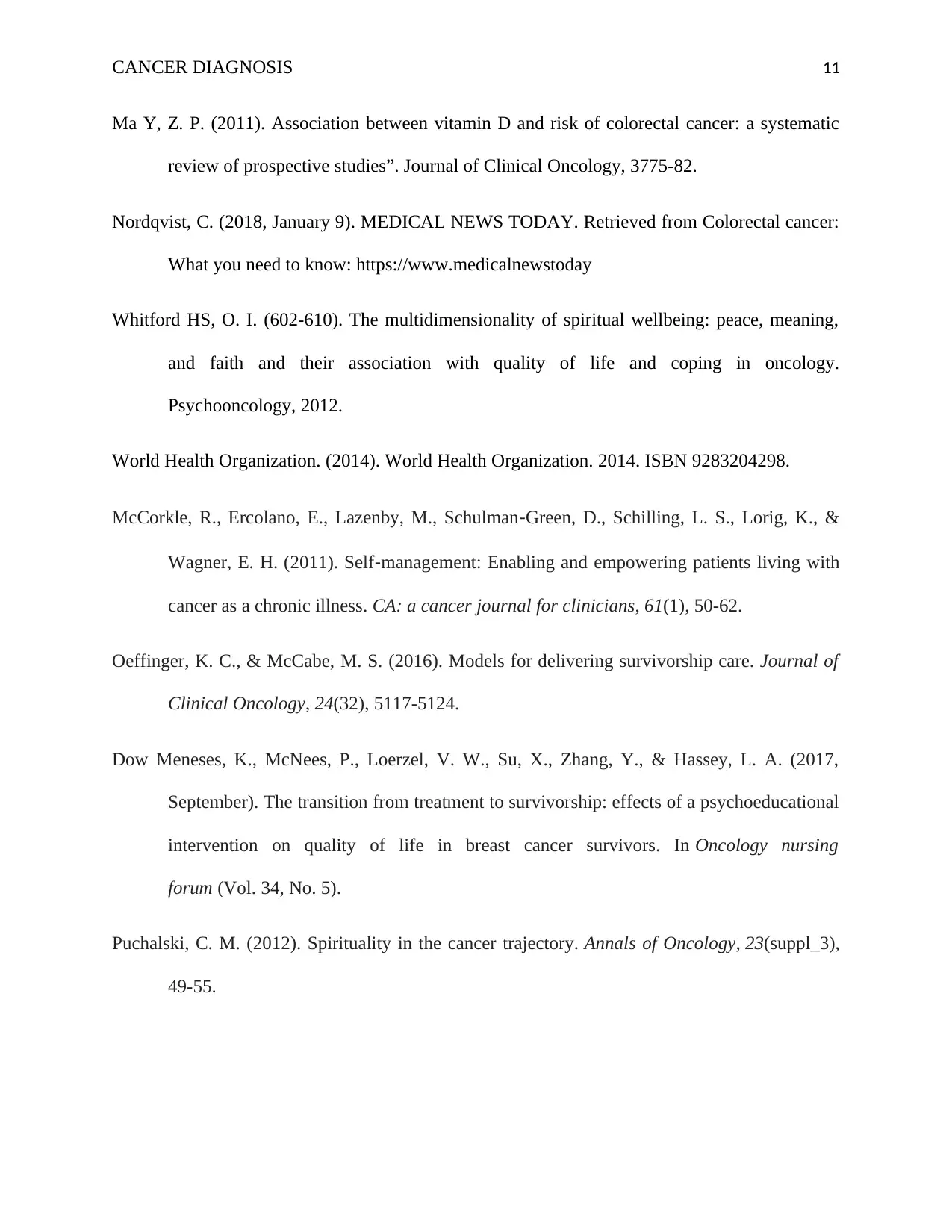
CANCER DIAGNOSIS 11
Ma Y, Z. P. (2011). Association between vitamin D and risk of colorectal cancer: a systematic
review of prospective studies”. Journal of Clinical Oncology, 3775-82.
Nordqvist, C. (2018, January 9). MEDICAL NEWS TODAY. Retrieved from Colorectal cancer:
What you need to know: https://www.medicalnewstoday
Whitford HS, O. I. (602-610). The multidimensionality of spiritual wellbeing: peace, meaning,
and faith and their association with quality of life and coping in oncology.
Psychooncology, 2012.
World Health Organization. (2014). World Health Organization. 2014. ISBN 9283204298.
McCorkle, R., Ercolano, E., Lazenby, M., Schulman‐Green, D., Schilling, L. S., Lorig, K., &
Wagner, E. H. (2011). Self‐management: Enabling and empowering patients living with
cancer as a chronic illness. CA: a cancer journal for clinicians, 61(1), 50-62.
Oeffinger, K. C., & McCabe, M. S. (2016). Models for delivering survivorship care. Journal of
Clinical Oncology, 24(32), 5117-5124.
Dow Meneses, K., McNees, P., Loerzel, V. W., Su, X., Zhang, Y., & Hassey, L. A. (2017,
September). The transition from treatment to survivorship: effects of a psychoeducational
intervention on quality of life in breast cancer survivors. In Oncology nursing
forum (Vol. 34, No. 5).
Puchalski, C. M. (2012). Spirituality in the cancer trajectory. Annals of Oncology, 23(suppl_3),
49-55.
Ma Y, Z. P. (2011). Association between vitamin D and risk of colorectal cancer: a systematic
review of prospective studies”. Journal of Clinical Oncology, 3775-82.
Nordqvist, C. (2018, January 9). MEDICAL NEWS TODAY. Retrieved from Colorectal cancer:
What you need to know: https://www.medicalnewstoday
Whitford HS, O. I. (602-610). The multidimensionality of spiritual wellbeing: peace, meaning,
and faith and their association with quality of life and coping in oncology.
Psychooncology, 2012.
World Health Organization. (2014). World Health Organization. 2014. ISBN 9283204298.
McCorkle, R., Ercolano, E., Lazenby, M., Schulman‐Green, D., Schilling, L. S., Lorig, K., &
Wagner, E. H. (2011). Self‐management: Enabling and empowering patients living with
cancer as a chronic illness. CA: a cancer journal for clinicians, 61(1), 50-62.
Oeffinger, K. C., & McCabe, M. S. (2016). Models for delivering survivorship care. Journal of
Clinical Oncology, 24(32), 5117-5124.
Dow Meneses, K., McNees, P., Loerzel, V. W., Su, X., Zhang, Y., & Hassey, L. A. (2017,
September). The transition from treatment to survivorship: effects of a psychoeducational
intervention on quality of life in breast cancer survivors. In Oncology nursing
forum (Vol. 34, No. 5).
Puchalski, C. M. (2012). Spirituality in the cancer trajectory. Annals of Oncology, 23(suppl_3),
49-55.
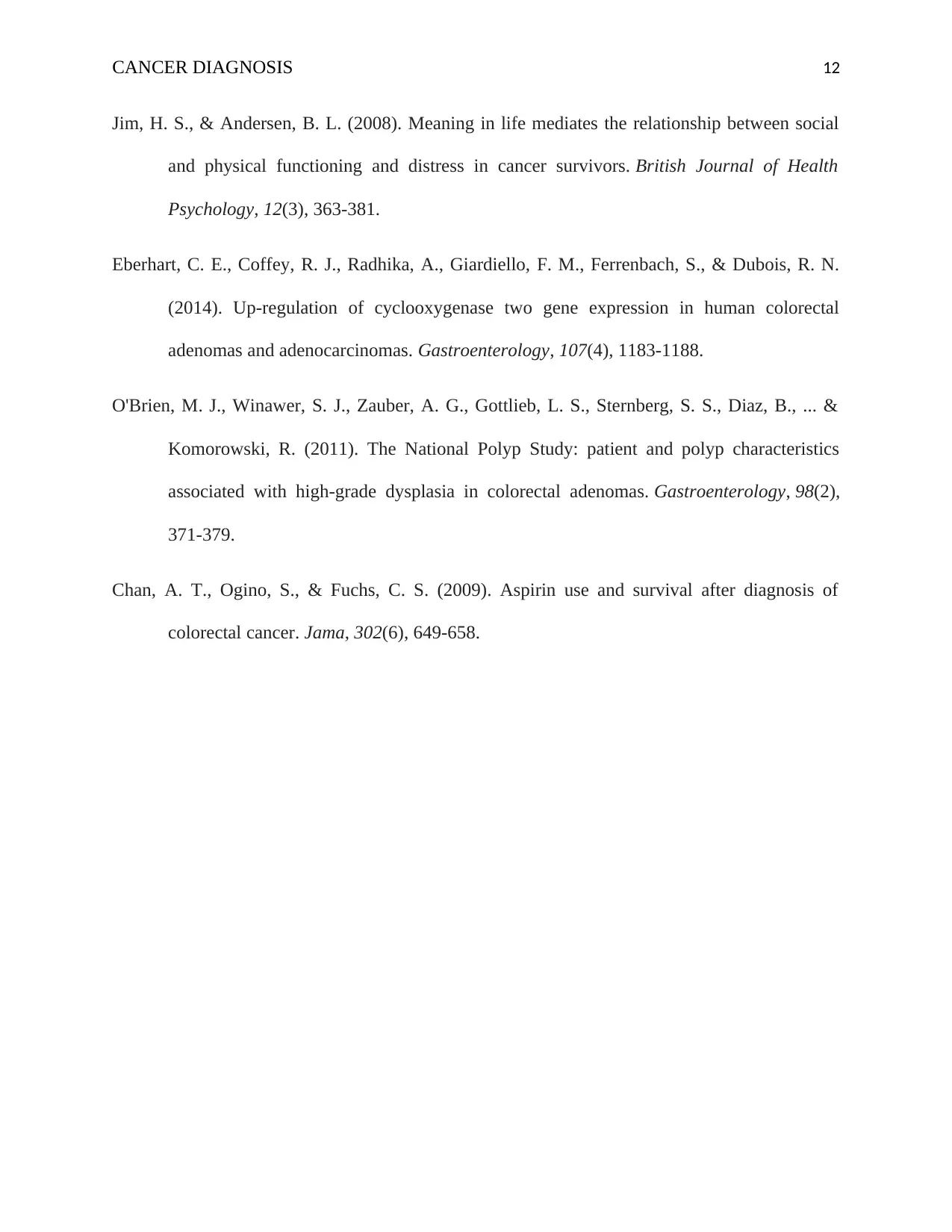
CANCER DIAGNOSIS 12
Jim, H. S., & Andersen, B. L. (2008). Meaning in life mediates the relationship between social
and physical functioning and distress in cancer survivors. British Journal of Health
Psychology, 12(3), 363-381.
Eberhart, C. E., Coffey, R. J., Radhika, A., Giardiello, F. M., Ferrenbach, S., & Dubois, R. N.
(2014). Up-regulation of cyclooxygenase two gene expression in human colorectal
adenomas and adenocarcinomas. Gastroenterology, 107(4), 1183-1188.
O'Brien, M. J., Winawer, S. J., Zauber, A. G., Gottlieb, L. S., Sternberg, S. S., Diaz, B., ... &
Komorowski, R. (2011). The National Polyp Study: patient and polyp characteristics
associated with high-grade dysplasia in colorectal adenomas. Gastroenterology, 98(2),
371-379.
Chan, A. T., Ogino, S., & Fuchs, C. S. (2009). Aspirin use and survival after diagnosis of
colorectal cancer. Jama, 302(6), 649-658.
Jim, H. S., & Andersen, B. L. (2008). Meaning in life mediates the relationship between social
and physical functioning and distress in cancer survivors. British Journal of Health
Psychology, 12(3), 363-381.
Eberhart, C. E., Coffey, R. J., Radhika, A., Giardiello, F. M., Ferrenbach, S., & Dubois, R. N.
(2014). Up-regulation of cyclooxygenase two gene expression in human colorectal
adenomas and adenocarcinomas. Gastroenterology, 107(4), 1183-1188.
O'Brien, M. J., Winawer, S. J., Zauber, A. G., Gottlieb, L. S., Sternberg, S. S., Diaz, B., ... &
Komorowski, R. (2011). The National Polyp Study: patient and polyp characteristics
associated with high-grade dysplasia in colorectal adenomas. Gastroenterology, 98(2),
371-379.
Chan, A. T., Ogino, S., & Fuchs, C. S. (2009). Aspirin use and survival after diagnosis of
colorectal cancer. Jama, 302(6), 649-658.
⊘ This is a preview!⊘
Do you want full access?
Subscribe today to unlock all pages.

Trusted by 1+ million students worldwide
1 out of 12
Related Documents
Your All-in-One AI-Powered Toolkit for Academic Success.
+13062052269
info@desklib.com
Available 24*7 on WhatsApp / Email
![[object Object]](/_next/static/media/star-bottom.7253800d.svg)
Unlock your academic potential
Copyright © 2020–2025 A2Z Services. All Rights Reserved. Developed and managed by ZUCOL.





